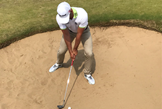How to practice like a Tour Pro
Published:
European Tour Pro Paul Waring talks through how he warms up before a round of golf – and what his favourite drill is to practice to get course-ready
If you just go to the range before you head to the tee and hit as many golf balls as you feel like with no real goal in mind – it’s well documented that you’re probably not doing yourself any real favours.
Maybe you don’t have a warm-up at all, or perhaps you just hit a couple of putts and a couple of bunker shots. Paul Waring’s pre-round routine is a lot more well rehearsed, but he says it’s not necessarily the time – but the repetitive nature of the routine that is crucial to how you perform. If you’ve got something that works for you, keep it as it is. But if you find you vary in the way you start a round too often – it might be that you need to start putting a little more work in to your pre-round warm-up.
For Paul Waring, it’s not about hitting 25 drivers on the range – it’s all about honing that short game to get it ready for the course. As he points out, that’s where you’re really going to make your score.
So how does he do it?
Warm-up routine before going to play
What Paul Says: My warm-up takes roughly an hour, including 10 minutes to get to the tee so it’s effectively a 50 minute warm-up. The only difference will be if there’s a bit of a walk from practice range to putting green, or a buggy in between range and first tee – but the actual bits don’t change.
I think that is one of the biggest things you can do in this sport. If something works for you and you know it works, don’t change it.
A couple of lads come out on tour and they change their clubs, change their coach, change their whatever and think that’s what you need to be a tour player. You don’t – you just need to do the same things you’ve always done, just do them more consistently and therefore do it better.
First up: Technical Putting
I’ll work technically at putting first. I’ve got a visio mirror with two pegs on the end of it – so basically I don’t even need to line it at a hole really but as long as I can start the ball on line then I know my putter is square. And with it being a mirror I can make sure my eyes are over it and it just helps me build a good solid base of what the day will bring.
I like to set it up to a hole on a very straight putt, because then I can reference what square looks like on my putter – I know that sounds daft but when I put the putter down on a green I know where the middle of the hole is because I know where square is on my putter.
Next: Head to the range
From the putting green I’ll go to the range but I’ll start with chipping on the range, just to either five yards or 10 yards to start.
Then I’ll go through a couple of pitching drills to really dial in my yardages. So I’ll start with 60yards then go 70, 80, 90, 100, and then I’ll go down in fives so to 95, 85, 75, 65. After that I’ll go in to the 150s with wedges and nine iron.
From there it’s just focusing on the golf swing and getting free from that point – the scoring side is done so I just need to get loose now. I tend to go 7 iron in to a long iron, utility 3 or 4 iron, then finish with a few drivers.
Back to short-game area
Once I’ve loosened up my swing, I’ll then head back to the short-game area and do a little chipping, and then go and do a bit in the bunkers to get a feel for the sand. Once I feel comfortable I’ll then just finish by rolling a couple of balls around the putting green and then go to the tee.
Favourite drill to practice
One of the big drills I really enjoy is in the bunker. To start with, I try to pace out a bunker shot. So if it’s a 20 yard bunker shot, I’ll times that number by three so that gives me 60. So I give myself 60 feet of error.
So I’ll try and hit 12 balls that totals below 60 feet of complete error. So for 10 balls it would be a six foot average, for 12 balls it brings the average down a bit.
For a 10 yard trap shot that brings the number down a bit to 30 feet, which is a 3 foot average for 10 balls. So it becomes under a three-foot average.
What I do is count up after the first six shots – to give myself a break like you would in golf – and go back and hit the last five – then count up what that last ball needs to do to. This is to put myself under the ultimate pressure so I actually know what I need to do on the course.
This helps because you’re going to come down the last hole in a tournament and no matter if you haven’t looked at the leaderboard all day you’re still going to know what you need to do or not – it’s whether you can hit the golf shot or not so it’s just getting yourself under that pressure.

